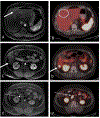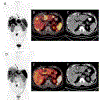Neuroendocrine Neoplasms of the Small Bowel and Pancreas
- PMID: 31557758
- PMCID: PMC9175236
- DOI: 10.1159/000503721
Neuroendocrine Neoplasms of the Small Bowel and Pancreas
Abstract
The traditionally promulgated perspectives of neuroendocrine neoplasms (NEN) as rare, indolent tumours are blunt and have been outdated for the last 2 decades. Clear increments in their incidence over the past decades render them increasingly clinically relevant, and at initial diagnosis many present with nodal and/or distant metastases (notably hepatic). The molecular pathogenesis of these tumours is increasingly yet incompletely understood. Those arising from the small bowel (SB) or pancreas typically occur sporadically; the latter may occur within the context of hereditary tumour predisposition syndromes. NENs can also be associated with endocrinopathy of hormonal hypersecretion. Tangible advances in the development of novel biomarkers, functional imaging modalities and therapy are especially applicable to this sub-set of tumours. The management of SB and pancreatic neuroendocrine tumours (NET) may be challenging, and often comprises a multidisciplinary approach wherein surgical, medical, interventional radiological and radiotherapeutic modalities are implemented. This review provides a comprehensive overview of the epidemiology, pathophysiology, diagnosis and treatment of SB and pancreatic NETs. Moreover, we provide an outlook of the future in these tumour types which will include the development of precision oncology frameworks for individualised therapy, multi-analyte predictive biomarkers, artificial intelligence-derived clinical decision support tools and elucidation of the role of the microbiome in NEN development and clinical behaviour.
Keywords: Neuroendocrine neoplasm; Neuroendocrine tumour; Pancreas; Small intestine.
© 2019 S. Karger AG, Basel.
Conflict of interest statement
Disclosure statement:
M. K. is an employee of Wren Laboratories; I. M. M. is a medical consultant for Wren Laboratories. All other authors declare no competing interests.
Figures







References
-
- Lawrence B, Gustafsson BI, Chan A, Svejda B, Kidd M, Modlin IM: The epidemiology of gastroenteropancreatic neuroendocrine tumors. Endocrinol Metab Clin North Am 2011. Mar;40:1–18, vii. - PubMed
-
- Boyar Cetinkaya R, Aagnes B, Thiis-Evensen E, Tretli S, Bergestuen DS, Hansen S: Trends in Incidence of Neuroendocrine Neoplasms in Norway: A Report of 16,075 Cases from 1993 through 2010. Neuroendocrinology 2017;104:1–10. - PubMed
-
- Frilling A, Clift AK: Therapeutic strategies for neuroendocrine liver metastases. Cancer 2015. Apr 15;121:1172–86. - PubMed
-
- Hauso O, Gustafsson BI, Kidd M, Waldum HL, Drozdov I, Chan AKC, et al.: Neuroendocrine tumor epidemiology: contrasting Norway and North America. Cancer 2008. Nov 15;113:2655–64. - PubMed

